We hope that spring will finally be underway by the time this newsletter goes out, and wish everybody a successful growing season in 2018. First, two dates for your diary:
PLANT SALE, TOWN SQUARE Saturday May 19th 9.00 a.m.
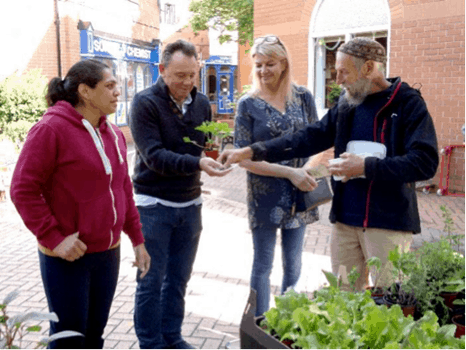
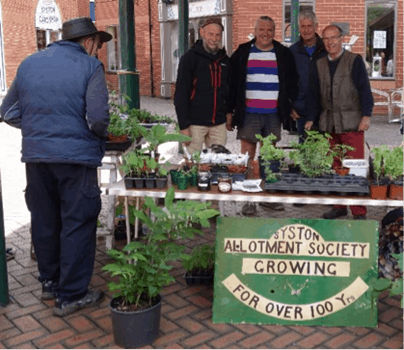
A plant sale will be held in the Town Square (outside the former Co-op, now Poundstretcher) on the morning of Saturday May 19th from 9.00 a.m. until around 12.00 mid-day. This is an important fund-raising occasion for the Allotment Society, a really useful source of seedlings for those who need some, and a way of finding a home for any plants and seedlings that are surplus to your requirements. Please bring donated plants – each with a label saying what it is please – to the area outside the allotment cabin by the evening of Friday May 18th, or you can bring them to the Town Square early on 19th. All donations much appreciated: seedlings, house plants etc.
OPEN DAY 2018, SUNDAY 5th August
There will be an Allotment Open Day on 5th August 2018 including produce, competitions and refreshments. This has been a great success in the past. It’s for anyone to come along and enjoy themselves and look at the plots, maybe with a view to going on the waiting list. If you have ideas for activities or competitions do speak to a committee member or come along to a monthly committee meeting.
PLOT HOLDERS’ OPEN DAY COMPETITIONS:
Kids only:Tallest sunflower
Best drawing of your allotment
Adults or children:Best box or basket of produce
Best cake containing at least one ingredient from your allotment
Best bunch or bouquet of flowers grown on your allotment
IF YOU ENTER ANYTHING PLEASE MAKE SURE THAT YOU ATTACH YOUR NAME AND PLOT NUMBERSECURELY TO EACH ENTRY SUBMITTED. (SORRY, ENTRIES WITHOUT DETAILS CANNOT BE JUDGED). Thank you!
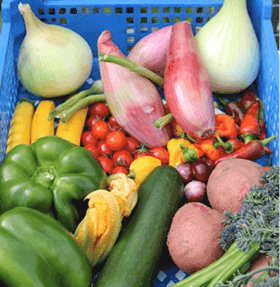
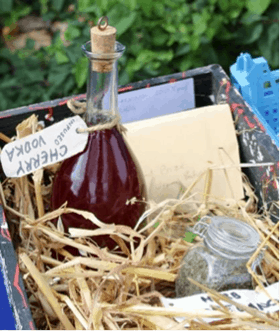
WELCOME TO ALL NEW PLOT HOLDERS
We hope you will soon feel at home on the allotments. Please don’t hesitate to speak to other plot holders if you have questions. The Syston Allotment Society has a Facebook page: https://www.facebook.com/groups/103768843053/ where you can ask for information and read other people’s comments, and where the Chair puts a monthly summary of what’s likely to need doing on your plot at each time of year. The Facebook page is a ‘public’ group page (in contrast to our own personal pages) which focusses on allotment matters great and small. There is a new Allotment Society web site: https://www.systonallotmentsociety.uk The noticeboard just inside the gates is a good source of information.
There is also a shop in the portacabin, selling compost, canes, pelleted chicken manure and so on. Prices are extremely competitive. Committee members have the key.
The allotments are managed and supported by Syston Town Council. You should have received a copy of the Syston Town Council Allotment Rules: if not, just ask. Day-to-day issues are addressed by a committee of volunteer plot holders. You are very welcome to join the committee which is as informal as possible while adhering to the necessary format for meetings. It meets on the first Tuesday of each month at 7.45 at Syston Social Club. Any plot holder is welcome to attend if they have an idea they want to discuss, or just come along and listen, even if they are not committee members. Current committee members are listed on the notice board and later in this newsletter, and new members are always welcome.
SYSTON ALLOTMENT PORTALOO
There is now a portaloo on the allotment site on a trial basis. The portaloo is for ALL PLOTHOLDERS. To use it you will need to know the combination for the lock which was sent out with the 2018 rent letter from the council. If you do not know the combination, please ask a committee member, other plot holders, or put a message on Facebook and someone will send it as a private message. Incidentally there is a short instructional video on Facebook, all about how to use (or perhaps operate is a better word) the portaloo.
When we conducted a survey about toilet facilities, there were many generous offers from plot holders willing to go on a cleaning rota. With so many volunteers, it should mean each person needs to check or clean only twice a year (assuming weekly checks of the portaloo). We will put a rota on the notice board but before we do, please can you let us know whether anything has changed since the survey? Here are the plot numbers of those who said yes to checking / cleaning the portaloo, thank you to all:

ARE YOU ON THIS LIST?
8B, 10B, 12B, 17B, 28A, 28B, 35A, 37A, 38A, 38B, 43B, 44B, 49A, 54, 55A, 59B, 60A, 62A, 64B, 66B, 70A, 71, 73B.
If you are on the list but can no longer help, or if you are not on the list but would be willing to check the toilets twice a year, please let Kate Windridge know on Plot 54 (leave a note in the greenhouse if I’m not there), or put a message on the allotment Facebook page.
The cleaning rota will go on the notice board, giving plot numbers only, not names.
COMPOSTING
Do you have any tips on composting? If so, please let Kate H (Plot 19B) or Kate W (Plot 54) know for the next newsletter. Experienced plot holders will have many years of successful composting and newcomers to these plots may be glad of your advice.
Syston Allotments are on very sandy soil. A soil expert (Stephen Trudgill [1]) says ‘Soil is formed when mineral matter reacts with the organisms, air, and water present at the surface of the earth.’ Nature provides us with the air and minerals (gardeners also adjust these!) and – with luck – with water. However the extreme sandiness here means that the crucial organic matter easily leaches out and needs replacing much more intensively than would be the case on a clay soil. One excellent and cost-free way of helping the process is to make your own compost: although ‘making’ is perhaps the wrong word because compost actually makes itself if you provide suitable materials and conditions.
There are plenty of websites and publications that give good advice on compost making, but here are a few pointers we (Plot 54) have found useful.
- Ideally construct two compost ‘bays’ or bins so that one can be used for recent peelings/weeds etc while the other has been left to mature for a while. We removed one of ours to put up a new shed and have regretted it ever since because we end up with a huge mountain of detritus and have to dig the ‘ripe’ compost from under a teetering pile.
- Turn compost twice a year to let air in (early spring is an especially good time).
- Avoid adding lumps of wood because wood uses up a lot of useful nitrogen during its decomposition. However, little sticks and small twiggy pieces are excellent because they provide potassium and help to keep plenty of air in the heap. Think green and brown. You need a mixture of the green (leafy/fleshy material) and the brown (twiggy/straw-y dry material).
- Every few layers of compostable material, add a shovelful or two of soil from your plot, spread over the top of the heap. This will provide all the beneficial bacteria and microorganisms the heap needs to keep working and you will get usable compost much more quickly.
- If you are adding grass cuttings don’t add them all in one big dollop. They will form a sludgy stinky mass. It’s better to sprinkle them on in layers.
- Save all vegetable waste from the kitchen except cooked material. Also avoid onion, or potato and tomato (the latter might reintroduce white rot and blight spores respectively).
- Add all weeds from your plot (saves labour taking them away) EXCEPT couch grass and bindweed. We really don’t worry about weed seeds. They will often be destroyed in the heat of the heap, and even if they are not, nobody can avoid weeds. They are a sign of healthy soil.
- If you are so inclined, bear in mind Bob Flowerdew’s recommendations about human liquid compost activator which is apparently particularly effective after an evening of beer sampling.
WILDLIFE ON ALLOTMENTS
You may have noticed that the pond and the small beds near it are planted up or seeded mainly with native wild plants. One reason for doing this is to attract pollinators to our plots. Researchers from Lancaster2 have just published work showing that if gardeners want to help bees, they need to know that non-native species of flower may not be as good for bees as native UK species.
Bees use pollen to make something called ‘bee bread’ which is a long term food supply for young bees, stored in the hive. The bee bread is made from pollen and from a wide range of friendly bacteria. Bees can get a much wider range of these bacteria from native species than non-native species. There have to be many types of bacteria for at least two reasons; first to stop the bread going mouldy, and second to keep the bees healthy. Rather like people, restricting the range of bacteria in their gut makes bees more susceptible to infection. We all need diverse ‘microbiomes’.

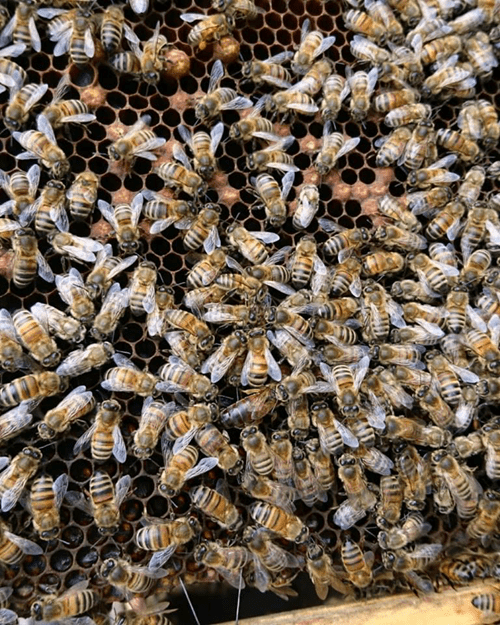
Can you spot the Queen?
Another insect that has been in the news lately is the ladybird – well known for its importance in controlling pests, especially aphids. There are 47 different kinds of ladybird in the UK. Twenty six of these are brightly coloured, and the commonest is the 7-spot which lives in places like nettles, brambles, gardens, apple trees, long grasses and hedgerows. It has three spots on each red wing case, and one in the middle (half on one wing case, half on the other). The smaller 2spot is also common (2 black spots on a red background). The 2-spot has a black form as well as the red form, which confusingly can have two to four red spots on a black background.
Different types of ladybird like different environments and eat different pests so for example you will not find the rare 5-spot ladybird on the allotments – it lives on shingle river banks.
The reason that ladybirds are in the news is that another common ladybird, the harlequin, arrived in the UK in 2004 and there are concerns that it is such a fast breeder and has so few predators that it will eventually do better than the UK ladybirds. Have you seen any?
The harlequin has an orange or red form with 0 to 21 black spots, and a black form with 2 to 4 red spots (sounds rather like the native 2spot in its black form).
They tend to be a little larger than native ladybirds and almost all have brown legs where many native ladybirds (but not all) have black legs. If you are interested in trying to identify the ladybirds you find here is a link to a web site with information:
http://www.ladybirdsurvey.org/ladybirds.aspxThere is also a ladybird survey organized by Dr Helen Roy: http://www.ladybird-survey.org There is no space in a local newsletter to cover all the wildlife your plot may shelter. However we should mention hedgehogs because they are disappearing at an alarming rate: the Wildlife Trusts say they are disappearing from the world at the same rate as tigers. The Wildlife Trust website describes ways of helping hedgehogs: http://www.wildlifetrusts.org/hedgehogs. A couple of things we could do on allotments is to provide nesting sites for them, and to minimize or cut out the sort of slug pellets that affect the hedgehogs. If you find a sick or injured hedgehog you can contact the British Hedgehog Preservation Society for help: https://www.britishhedgehogs.org.uk

A harlequin: note the brown legs
ARE WE CONTRIBUTING TO UK FOOD SECURITY?
It is well known that growing your own food contributes to general well-being and to having a healthy diet. But how much of the nation’s food actually comes from people growing their own? Are you interested in helping to find out?
If so have a look at a research project called Measure Your Harvest. It is funded for five years by the government through the Engineering and Physical Sciences Research Council to help find out how home-growing contributes to national food security, among other things.
To take part you will need a tape measure and a set of scales, and access to the internet. The project involves giving the weight of your crops on line, plus the area of the part of the plot they grew on. Here is a link to the information you need: https://myharvest.org.uk
It is heartening to see that the government’s funding of major projects like this indicates that they are paying serious attention to the impact of allotment gardening and similar activities. On that cheerful note, good gardening everybody!
Syston Allotment Committee members:
-
Plot 15BRichard ThorpeChair/Poultry Warden
-
Plot 65ATerry BaileyTreasurer
-
Plot 62AAnn & Marie ShellardJoint Secretaries
-
Plot 53BShane Briggs
-
Plot 59BBeth Cowley
-
Plot 73BRichard Kirk
-
Plot 23BGerald Pownall
-
Plot 11Mick Streetly
-
Plot 54Paul & Kate Windridge
ACKNOWLEDGEMENTS:
Photos by Kate Hubbard, Kate Windridge, & Grace Windridge-Hicks.
Text: Kate Windridge.
Wordsearch: Kate Hubbard.
Many thanks to Syston Town Council for providing printing services.
1. Stephen Trudgill, 1989. Soil Types: A field identification guide. FSC
2. http://www.lancaster.ac.uk/news/articles/2018/ honeybees-are-struggling-to-getenough-good-bacteria



